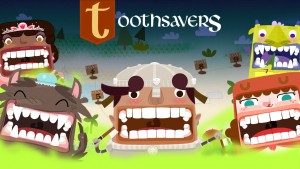As a parent of a 4-year-old, I know that mobile apps are a) incredibly popular with preschoolers and b) that getting my daughter to brush her teeth twice a day is HARD. In my professional role as VP of Digital at The Ad Council, I recently had the opportunity to work on developing Toothsavers, a mobile app for our Children’s Oral Health campaign.

The challenge for this campaign was to motivate parents to take action to reduce their children’s risk of oral disease by making sure their kids are brushing their teeth for two minutes, two times a day. We did this through television and radio PSAs, out of home advertising, banners, social media and a website with a series of entertaining videos for kids (and parents) to watch while they brush. When my team was asked to come up with digital ideas on how to extend the campaign even further, I thought, “There should be an app for that.” And while there are a few tooth brushing apps out there for parents, I thought there was room for one that was free, educational and fun. Most importantly, one that was informed by a message we already knew was effective from our research and initial campaign results.
This was the first app my team managed the production of from concept through to launch – and as a result, we learned a lot along the way. For anyone in this space considering an app as a way to raise awareness or create new habits, I wanted to share my own key learnings.
Finding the right developer is crucial
The first step once our sponsor approved the app was to find a top notch educational app developer who could work with our lower non-profit budget. Luckily, my background in youth marketing means I still have extensive contacts in this space. I was able to reach out and ask folks who they would recommend. I also went to events like the Sandbox Summit at M.I.T. and the Digital Kids conference at last year’s Toy Fair and did a lot of research online. Review sites like the Children’s Technology Review and Common Sense Media are a great place to look for developers. We were lucky enough to receive five substantive proposals from studios who were all immersed in building apps for young children. In the end, we chose Toboggan Studio in Montreal. They proposed building two games and one brushing companion in one app for both iOS and Android as well as a desktop version. Toboggan delivered on all fronts.
Give yourself plenty of time

You can’t use the same timeframe you would to launch a website when you are creating a mobile app from scratch, especially one that includes a game. We’re used to shorter development cycles for digital projects at the Ad Council and had planned on launching our app sooner than we did. We learned that you have to build in time for extensive testing (with kids and anyone you can get to play, a lot) and constant iterating to get the game balance right. Our app originally required kids to brush morning and night consecutively for several days in order to unlock new characters. We had magic apples parents could use in case a day was skipped. In the end, it became too complicated, and we just allowed unlocking based on the number of sessions. We had to make changes to the art to make sure it would appeal to our target audience and ensure that touch screen sensitivity was optimized for both iOS and Android devices.
Promotion: The Hidden Cost
Just because you build a great educational app, doesn’t mean they will come. App promotion requires traditional PR, blogger outreach, paid or in our case donated media on mobile ad networks, Facebook and through Google Grants – and even then there is no guarantee you will break through. We had some nice initial PR hits including a wire story but are still waiting on reviews from some of the most influential reviewers in the children’s media space. There is also a growing body of knowledge specifically around app marketing that ties into measuring engagement beyond just downloads, having push alerts (we have brush reminders) and the ability to share through social media. Reviews and ratings also matter, as does app store search optimization and having a video trailer — basically a whole new world of tactics we were not familiar with until now.
We just launched Toothsavers a few weeks ago: the downloads have been steady, and we’re happy with the average time users are spending on the game and the brushing companion. We are already learning from our analytics what’s working and what’s not. Given the cost, time and promotional efforts launching an app requires, app development is not for every non-profit or social marketing campaign. That said, if we are successful, and the high engagement levels continue, we hope to help create new brushing habits for thousands of children and their parents as well as contribute to preventing oral disease later in life.
 Anastasia Goodstein serves as Vice President of the Ad Council’s Digital group, where she manages online strategy for all of the Ad Council’s campaigns and the Ad Council brand. The Ad Council first created the category of public service advertising in 1942. We produce, distribute and promote public service campaigns on behalf of non-profit organizations and government agencies.
Anastasia Goodstein serves as Vice President of the Ad Council’s Digital group, where she manages online strategy for all of the Ad Council’s campaigns and the Ad Council brand. The Ad Council first created the category of public service advertising in 1942. We produce, distribute and promote public service campaigns on behalf of non-profit organizations and government agencies.
She is also the co-editor of the Ad Council blog AdLibbing.org, one of the leading resources for social marketers.
For more free and fun resources to encourage oral health for young children, check out Sesame Workshop’s Healthy Teeth, Healthy Me campaign.



